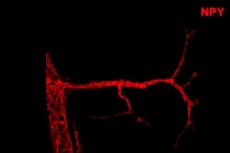New publications
Study identifies novel neuropeptide involved in regulating calorie expenditure
Last reviewed: 02.07.2025

All iLive content is medically reviewed or fact checked to ensure as much factual accuracy as possible.
We have strict sourcing guidelines and only link to reputable media sites, academic research institutions and, whenever possible, medically peer reviewed studies. Note that the numbers in parentheses ([1], [2], etc.) are clickable links to these studies.
If you feel that any of our content is inaccurate, out-of-date, or otherwise questionable, please select it and press Ctrl + Enter.

A research team from the University of Oxford and the Obesity and Comorbidity Research Centre (OCRC) has identified a new component of the peripheral nervous system that boosts the body’s energy metabolism. The discovery, published in the journal Nature, paves the way for the development of simpler, more affordable drugs to control obesity and weight gain, regardless of how much food is consumed.
Main results of the study
Researchers have discovered that neuropeptide Y (NPY), known for its role in transmitting signals between neurons in the central nervous system, also functions in the peripheral nervous system. For the first time, this neurotransmitter has been shown to be able to interact with fat cells (adipocytes) and protect the body from obesity.
Why is this important?
- Central nervous system (CNS): In the brain, NPY stimulates appetite.
- Peripheral nervous system (PNS): In the periphery, NPY speeds up metabolism and increases energy expenditure.
Key discovery: In the peripheral nervous system, NPY stimulates the formation of "thermogenic" fat cells (brown and beige fat), which burn calories to produce heat instead of storing them.
Mechanism of action
The researchers studied the sympathetic part of the autonomic nervous system, which is responsible for the body's response to stress and increased energy expenditure. Traditionally, the sympathetic nervous system was thought to use norepinephrine for its functions, but the new study found that it also uses NPY.
NPY activity in the periphery:
- Stimulates the formation of brown fat from "mural cells" (cells surrounding blood vessels).
- Increases thermogenesis, the process of producing heat using energy.
Results of animal experiments:
- Mice that genetically lacked NPY in the sympathetic nervous system exhibited obesity, low thermogenic activity, and an increased risk of developing diabetes.
- Mice with preserved NPY that ate the same amount of food remained protected from obesity due to increased metabolism.
Important conclusions
The Role of NPY in Weight Management:
- On the periphery, NPY promotes fat burning.
- In the central nervous system, it stimulates appetite.
Genetic research:
- Genetic data support that changes in NPY are associated with obesity in humans, but not with changes in eating habits.
Nerve degeneration:
- In mice with diet-induced obesity, the nerves that produce NPY begin to degenerate, reducing protection against fat accumulation.
Future Treatments for Obesity
The researchers suggest that future drugs could target NPY receptors in the peripheral nervous system, which would:
- Increase metabolism.
- Increase calorie burning.
- Help control weight.
Advantages:
- The new therapy does not require complex molecules that must penetrate the blood-brain barrier.
- The possibility of more affordable production and development of drugs.
Conclusion
The discovery of the role of NPY in the peripheral nervous system offers hope for the development of new therapies for the treatment of obesity aimed at increasing calorie burning. These results highlight the importance of integrating central and peripheral mechanisms in managing energy balance and maintaining health.
